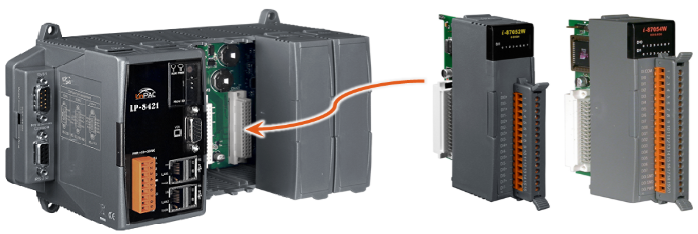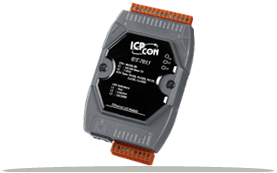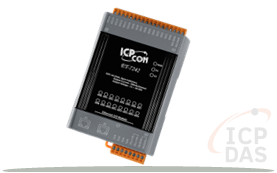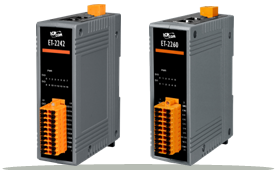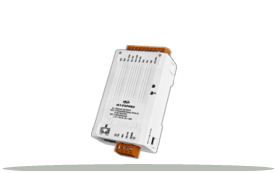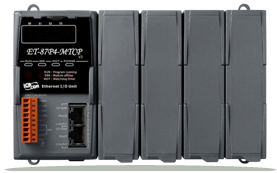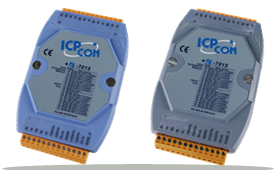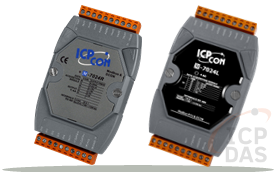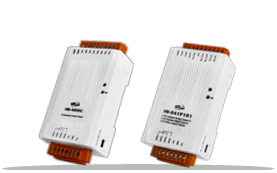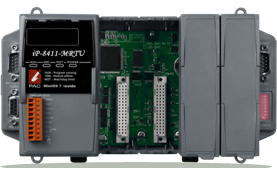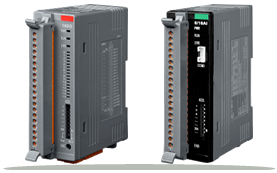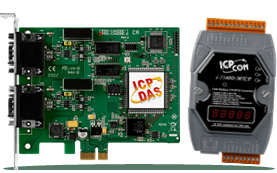LP-8000 Introduction

Nowadays, Linux has been adopted widely by many users because of the properties of stability, open source, and free of charge. In the mean while, owing to the great supports from more and more companies and the mature development, Linux is now becoming one of the most popular OS on the market. Furthermore the hardware requirements of Linux OS in embedded system is not high, just only 386 CPU or better and 8 MB RAM. Therefore, besides Win CE of Microsoft, Linux has been already become another good choice in embedded OS.
The LinPAC-8000 is a second generation Linux-based PAC from ICP DAS and is equipped with a powerful CPU module running a Linux kernel 2.6/3.x operating system, various communication interfaces (VGA, USB, Ethernet and RS-232/485) and slots for both high performance parallel bus type (high profile I-8K series) and serial bus type (high profile I-87K series) I/O modules.
Compared with the first generation LinCon-8000, not only is the CPU performance improved have been added (from 206 MHz to 500 MHz/1 GHz) and upgraded OS from Linux kernel 2.4 to Linux kernel 2.6/3.x, but many reliability features, such as dual LAN, redundant power input, and dual battery backup SRAM, etc., making the LinPAC-8000 one of the most powerful systems available.
Architecture (LinPAC=IPC+PLC)
The LinPAC-8000 gives users all of the best features of both traditional PLCs and Windows capable PCs. The LinPAC-8000 includes a VGA port allowing users to choose a regular LCD monitor for display of HMI application, USB port to connect with Keyboard, Mouse, USB device for storage or touch monitor, micro SD/SDHC memory for storage of program and data. The figure is the general application for LinPAC-8000.
Features
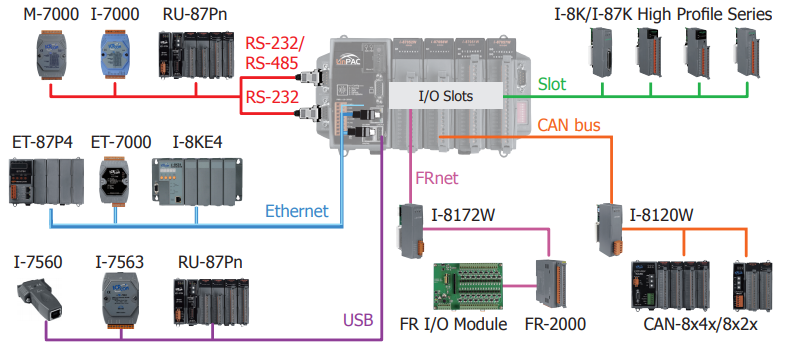
Development Environment
-
LinPAC SDK
ICP DAS provides the library file-libi8k.a which includes all the functions of the I-7000/8000/87k series modules. Users just install LinPAC SDK in Windows PC, the cygwin environment will be established automatically and users can develop LinPAC-8000 applications easily by GNU C Language. Apart from that, users can also use Java to develop LinPAC applications as well.
Note: Cygwin is a Linux-like environment for Windows.
Built-in Server
-
Web Server
-
Ftp Server, Telnet Server, SSH Server
-
UPnP
Supported Communication
-
Wireless LAN, PPP over Modem, GPRS, Ethernet, Dual LAN
-
VxComm
-
Expansion serial ports
-
Support USB to Serial Converter --- I-7560, I-7561, I-7563
Supported Protocol
-
CAN Bus Network, Industrial Modbus TCP/RTU, SNMP
Security
-
Unique Serial Number
-
Firewall, NAT
-
VPN
Java
-
JVM, JIOD( Java I/O Driver)
Interpreter
-
Perl, PHP
GUI
-
GTK+ Library
Other
-
USB WebCam
-
RAM Disk
|
|
||||||||||
|
Standard LP-8000 (Linux Kernel Inside)
The controller supports following software development tools: 1. LinPAC SDK for Linux environment 2. LinPAC SDK for Windows environment |
||||||||||
| Model | OS | CPU | System Memory | Non-Volatile Memory | Storage | VGA Resolution |
Ethernet Port |
USB Port | RS-232/ RS-485 |
I/O Slot |
|---|---|---|---|---|---|---|---|---|---|---|
| LP-8121
|
Linux kernel 3.2.14 | Cortex-A8, 1.0 GHz |
512 MB DDR3 SDRAM | 512 KB MRAM, 16 KB EEPROM |
512 MB Flash, 4 GB microSD card |
1280 x 1024
|
2 | 2 | 2 | 1 |
| LP-8421
|
4 | 4 | ||||||||
| LP-8821
|
8 | |||||||||
|
|
||||||||||
|
Standard LP-8000 (Linux Kernel Inside)
The controller supports following software development tools: 1. LinPAC SDK for Linux environment 2. LinPAC SDK for Windows environment |
||||||||||
| Model | OS | CPU | System Memory | Non-Volatile Memory | Storage | VGA Resolution |
Ethernet Port |
USB Port | RS-232/ RS-485 |
I/O Slot |
|---|---|---|---|---|---|---|---|---|---|---|
| LP-8141-EN
|
Linux kernel 2.6.19 | PXA270, 520 MHz |
128 MB SDRAM | 512 KB SRAM, 16 KB EEPROM |
96 MB Flash, 4 GB microSD card |
800 x 600
|
2 | 1 | 2 | 1 |
| LP-8441-EN
|
4 | 4 | ||||||||
| LP-8841-EN
|
8 | |||||||||
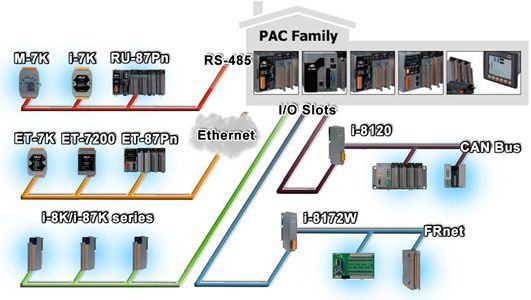
Remote I/O Selection
Ethernet
The available Ethernet I/O devices are ET-7000, ET-7200, ET-87P4/8-MTCP and I-8KE4/8-MTCP. The PAC can access them in Modbus/TCP protocol. A nModbus.dll is provided for C#, VB.net programming.
RS-485
The PACs are equipped with the RS485 COM ports which enable the transmission rate up to a maximum of 115.2 Kbps. The medium for connection is a twisted-pair, multi-drop, 2-wire RS-485 network that can link I-7000, M-7000, RU-87Pn with high profile I-87K modules. To access M-7000, a nModbus.dll is provided for C#, VB.net programming. To access I-7000 and RU-87Pn with high profile I-87K modules, PACSDK is provided for C#, VB.net, VC and VB programming.
FRnet
FRnet is an innovative industrial field bus that has many special features, such as high-speed deterministic I/O control, real I/O synchronization capabilities, non-protocol communication, and easy programming. With a FRnet communication module (I-8172W), the PAC can link FRnet I/O modules to implement high-speed distributed I/O (FR-2000 series). To access I-8172W, a pac_i8172w.dll is provided for C#, VB.net, VC and VB programming.
CAN Bus
The Controller Area Network (CAN) is a serial communication way, which efficiently supports distributed real-time control with a very high level of security. It provides the error-processing mechanisms and concepts of message priority. These features can improve the network reliability and transmission efficiency. Furthermore, CAN supplies the multi-master capabilities, and is especially suited for networking“intelligent” devices as well as sensors and actuators within a system or a sub-system. With I-8123, I-8124, I-87120, the PAC is able to demonstrate every feature of CAN, CANopen, and DeviceNet.

